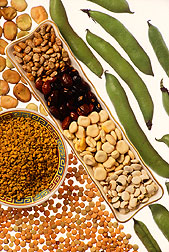This page has been archived and is being provided for reference purposes only. The page is no longer being updated, and therefore, links on the page may be invalid.
|
|
Boron Supports Bone GrowthBy Judy McBrideFebruary 21, 1997 Chicken drumsticks are giving boron a leg to stand on as an element that may be important for optimum bone growth in people. Studies of growing chicks show that boron--found mostly in fruits, vegetables, legumes and nuts--can partially compensate for a low vitamin D intake in bone formation. Like human children, chicks raised on a diet deficient in vitamin D develop rickets, a bone deformity in which the actively growing ends, or growth plates, are weak from lack of minerals. Adding boron to the vitamin D-deficient diet significantly improved the accumulation of minerals in the chicks’ growth plates, according to researchers with USDA’s Agricultural Research Service. They added several levels of boron to the chicks’ diets to approximate the range people might get through typical diets. After four weeks, they inspected the growth plates under a microscope. Those closest to normal came from chicks getting the highest level of boron--4.2 milligrams per kilogram of feed. This is equivalent to the boron levels in a human diet containing plenty of fruits and vegetables. Even in the chicks raised on diets containing adequate vitamin D, the growth plates tended to mineralize better when the animals got ample boron. Scientific contact: Curtiss Hunt, USDA-ARS Grand Forks Human Nutrition Research Center, Grand Forks, N.D., phone (701) 795-8423, e-mail chunt@gfhnrc.ars.usda.gov |

